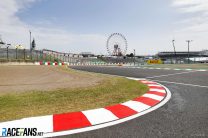Suzuka was originally built by Honda as a test track and opened in 1962. Twenty-five years later it welcomed the Formula One world championship for the first time, albeit with a few revisions to the course to improve safety including the construction of a chicane in front of what had been a very fast final corner.
The unique crossover layout won favour among the drivers and was the scene for many championship-deiciding races at the end of the season in the eighties and nineties.
Partly because of the compact nature of the layout few changes have been made to its configuration. The final chicane went through some revisions and the daunting 130R corner that precedes was reprofiled in 2003 after Allan McNish was fortunate to survive a huge crash during qualifying the year before which punched a hole in the barrier.
Following a two-year absence from the calendar when Toyota’s Fuji Speedway took over as the host of the Japanese Grand Prix, Suzuka returned to the F1 schedule in 2009. However the 2014 race was overshadowed by a serious accident involving Jules Bianchi, who suffered serious head injuries and died nine months later.
| Lap data | |
| Lap length | 5.807km (3.608 miles) |
| Race laps | 53 |
| Race distance | 307.471km (191.054 miles) |
| Pole position | Left-hand side of the track |
| Lap record* | 1’31.540 (Kimi Raikkonen, 2005) |
| Fastest lap | 1’27.319 (Lewis Hamilton, 2017, qualifying three) |
| Maximum speed | 328kph (203.81 mph) |
| DRS zone/s (race) | Pit straight |
| Distance from grid to turn one | 405m |
| Car performance | |
| Full throttle | 66% |
| Longest flat-out section | 994m |
| Downforce level | High |
| Gear changes per lap | 48 |
| Fuel use per lap | 1.89kg |
| Time penalty per lap of fuel | 0.074s |
| Strategy | |
| Pit lane time loss | 17.65s |
| Tyres: | Drivers’ tyre selections |
*Fastest lap set during a Grand Prix
Data sources: FIA, Williams, Mercedes







